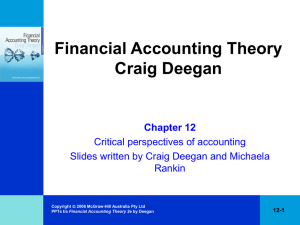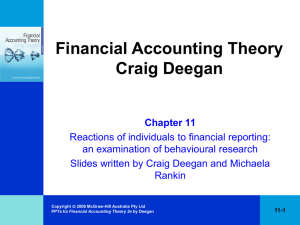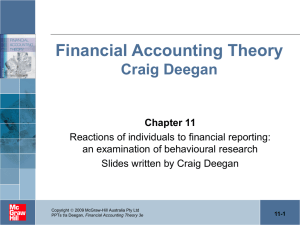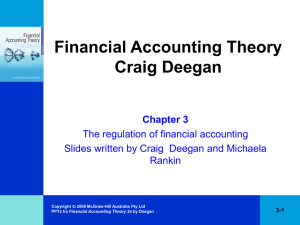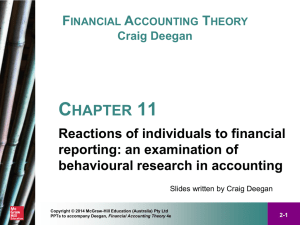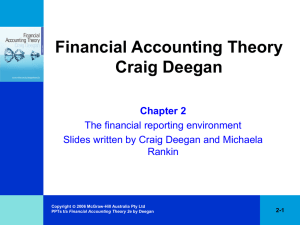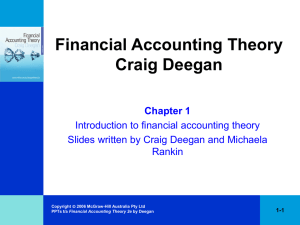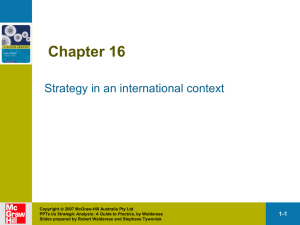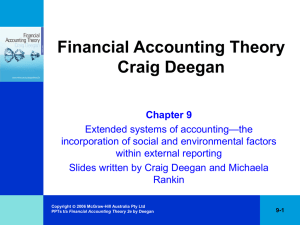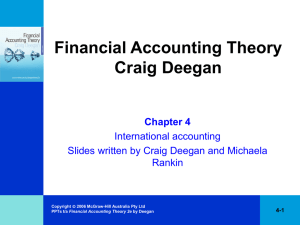ACCOUNTING Financial and Organisational Decision Making
advertisement
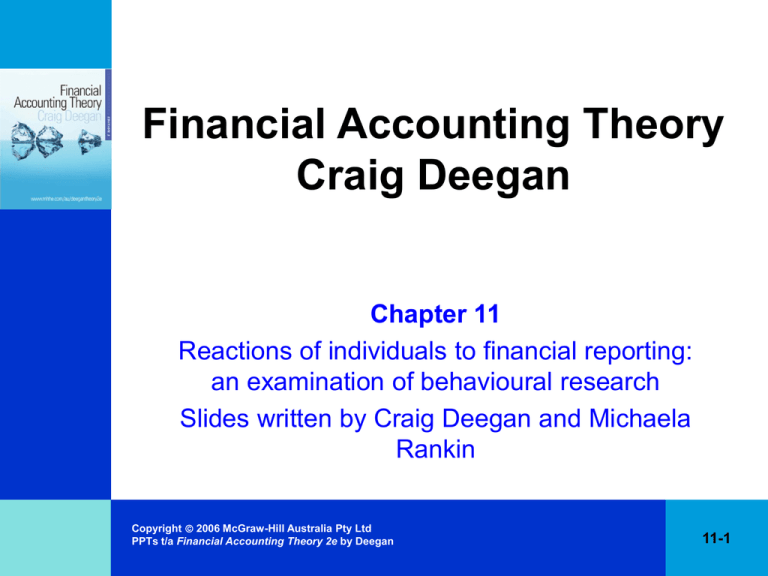
Financial Accounting Theory Craig Deegan Chapter 11 Reactions of individuals to financial reporting: an examination of behavioural research Slides written by Craig Deegan and Michaela Rankin Copyright 2006 McGraw-Hill Australia Pty Ltd PPTs t/a Financial Accounting Theory 2e by Deegan 11-1 Learning objectives • In this chapter you will be introduced to – how behavioural research differs from capital market research – how different accounting-related variables can be manipulated in behavioural research – how the results of behavioural research can be of relevance to corporations and the accounting profession for anticipating individual reactions to accounting disclosures Copyright 2006 McGraw-Hill Australia Pty Ltd PPTs t/a Financial Accounting Theory 2e by Deegan 11-2 Learning objectives (cont.) – how the results of behavioural research can form the basis for developing ways to more efficiently use accounting-related data – the limitations of behavioural research Copyright 2006 McGraw-Hill Australia Pty Ltd PPTs t/a Financial Accounting Theory 2e by Deegan 11-3 Introduction to behavioural research • Behavioural research examines how individuals react to various accounting disclosures • Grounded in behavioural decision theory • Goal is to describe actual decision behaviour, evaluate its quality and develop and test hypotheses of the underlying psychological processes Copyright 2006 McGraw-Hill Australia Pty Ltd PPTs t/a Financial Accounting Theory 2e by Deegan 11-4 Brunswick Lens Model • Used to explain behavioural research • Perspectives about the environment are generated (observed) through a ‘lens’ of imperfect cues • Statistical modelling is applied to determine the weighting (importance) of the various cues (independent variables) to the criterion event of success (dependent variable) Copyright 2006 McGraw-Hill Australia Pty Ltd PPTs t/a Financial Accounting Theory 2e by Deegan 11-5 Brunswick Lens Model (cont.) • Right-hand side models how the individual uses cues to make an ultimate decision about the issue under investigation • Left-hand side models the relationship between the actual phenomenon or event and the particular cues provided Copyright 2006 McGraw-Hill Australia Pty Ltd PPTs t/a Financial Accounting Theory 2e by Deegan 11-6 Applicability of the Lens Model • Structure of the Lens Model can be applied to almost any decision-making scheme – e.g. lending decision – explicitly considers inputs (use of cues), the decision process and outputs (ultimate decisions) Copyright 2006 McGraw-Hill Australia Pty Ltd PPTs t/a Financial Accounting Theory 2e by Deegan 11-7 Types of issues to be considered • At input level – scaling characteristics of individual cues – methods of presentation – context • At the level of processing the information – characteristics of the person making the judgement – characteristics of the decision rule • At the output or decision level – qualities of the judgement – self-insight Copyright 2006 McGraw-Hill Australia Pty Ltd PPTs t/a Financial Accounting Theory 2e by Deegan 11-8 Input level—use of cues • How and whether particular cues are used in decision making is particularly relevant to the accounting profession • If information items in financial statements are not used, then they could be deemed not material and therefore not requiring disclosure • The accounting profession is also interested in whether presentation (in financial statement or in a footnote) impacts decision Copyright 2006 McGraw-Hill Australia Pty Ltd PPTs t/a Financial Accounting Theory 2e by Deegan 11-9 Research evidence—the use of information items • In making predictions of financial returns, analysts are found to acquire earnings and sales information more often than other types (Pankoff & Virgil 1970; Mear & Firth 1987) • Studies questioned the provision of current cost information, subjects relied more on historical cost information (Heintz 1973; McIntyre 1973) Copyright 2006 McGraw-Hill Australia Pty Ltd PPTs t/a Financial Accounting Theory 2e by Deegan 11-10 Research evidence—the presentation of information • Different presentation formats found to influence users’ decisions – including bar charts, line graphs, pie charts and tables • Moriarity (1979) found students and accountants using Chernoff faces were able to outperform those using ratios in predicting bankruptcy, and models of bankruptcy Copyright 2006 McGraw-Hill Australia Pty Ltd PPTs t/a Financial Accounting Theory 2e by Deegan 11-11 Research evidence—the presentation of information (cont.) • Studies examining decision making by loan officers based on whether information is incorporated within the financial statements or included as footnotes found presentation made no difference (Wilkins & Zimmer 1983) • Provision of segment information reduced subjects’ reliance on past share prices (Stallman 1969; Doupnik & Rolfe 1989) Copyright 2006 McGraw-Hill Australia Pty Ltd PPTs t/a Financial Accounting Theory 2e by Deegan 11-12 Decision-making process • Studies have examined how the various cues are weighted • Judgements have been found to be consistent over time • Decision makers also have been found to employ simplifying heuristics when making a decision Copyright 2006 McGraw-Hill Australia Pty Ltd PPTs t/a Financial Accounting Theory 2e by Deegan 11-13 Decision-making heuristics • Three main simplifying heuristics have been identified – representativeness – anchoring and adjustment – availability Copyright 2006 McGraw-Hill Australia Pty Ltd PPTs t/a Financial Accounting Theory 2e by Deegan 11-14 Decision-making heuristics— representativeness • Decision makers often assess the likelihood of items belonging to a category by considering how similar the item is to the typical member of the category • An implication is that the subjects typically ignore the base rate of the population in question – may overstate the number of cases in a particular category Copyright 2006 McGraw-Hill Australia Pty Ltd PPTs t/a Financial Accounting Theory 2e by Deegan 11-15 Decision making heuristics—anchoring and adjustment • Individuals make an initial judgement or estimate and then only partial adjust their view as a result of additional information Copyright 2006 McGraw-Hill Australia Pty Ltd PPTs t/a Financial Accounting Theory 2e by Deegan 11-16 Decision making heuristics—availability • Relates to whether recollections of related occurrence or events can easily come to mind • The actual base rates of occurrence of an event are ignored Copyright 2006 McGraw-Hill Australia Pty Ltd PPTs t/a Financial Accounting Theory 2e by Deegan 11-17 Knowledge of heuristics in research • Useful to know of heuristics in use – if the heuristic results in inappropriate decisions being made, the tendency can be highlighted and action taken – the use of a heuristic by experts could be efficient relative to costly data-gathering and processing novices could then be advised to use the rule of thumb Copyright 2006 McGraw-Hill Australia Pty Ltd PPTs t/a Financial Accounting Theory 2e by Deegan 11-18 Decision output—decision accuracy • Research has considered how accurate the predictions are relative to the actual environmental outcomes – loan officers found to predict bankruptcy fairly regularly (Libby 1975) – bankers and accounting students also found to correctly predict bankruptcies (Zimmer 1980) – decision makers working in a team can outperform individual decision makers Copyright 2006 McGraw-Hill Australia Pty Ltd PPTs t/a Financial Accounting Theory 2e by Deegan 11-19 Protocol analysis • This form of behavioural research requires subjects to verbalise their thought processes while making decisions or judgements – common in auditing research • Understanding how judgements are made is important in improving those judgements • Useful in examining information search Copyright 2006 McGraw-Hill Australia Pty Ltd PPTs t/a Financial Accounting Theory 2e by Deegan 11-20 Protocol analysis (cont.) • Disadvantages include – the process of verbalising can have an effect on the decision process – a considerable portion of the information utilised may not be verbalised – subjects may provide verbalisations which are parallel but are independent of the actual thought process – criticisms of the coding methods Copyright 2006 McGraw-Hill Australia Pty Ltd PPTs t/a Financial Accounting Theory 2e by Deegan 11-21 Limitations of behavioural research • Research examining similar issues has generated conflicting results – difficult to determine causes of inconsistencies • Settings of studies often different to real-world settings – implications for generalisability • Very difficult to replicate cues available in the workplace • Students often used as surrogates • Small number of subjects often used Copyright 2006 McGraw-Hill Australia Pty Ltd PPTs t/a Financial Accounting Theory 2e by Deegan 11-22
